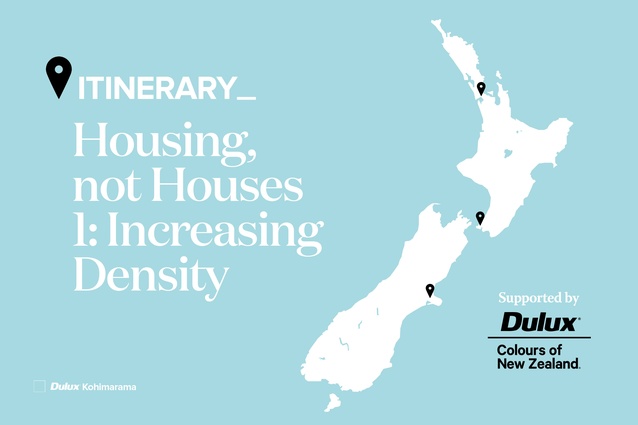Itinerary_ Housing, not Houses 1: Increasing Density
In this month’s Itinerary, supported by Dulux Colours of New Zealand, Julia Gatley and Andrew Barrie examine a range of contemporary apartment buildings that have contributed positively to urban densification and regeneration in our largest cities.
We hear continually that Aotearoa New Zealand is in the grips of a housing crisis, with under-supply, unaffordability, overcrowding and decreasing rates of home-ownership. Cold and damp interiors are contributing to poor health while, at the far end of that spectrum, thousands of leaky homes have been so soggy and rotten that they have been either substantially rebuilt or demolished and replaced. The array of housing problems is impacting upon Māori and Pacific people disproportionately.
Numerous commentators call for more land to be freed up for the construction of more houses. This is problematic because development beyond existing urban limits has multiple negative effects: the loss of productive agricultural land; the expense of new infrastructure; and an inability for authorities to provide adequate public transport to more low-density areas, necessarily meaning increased reliance on cars and all the problems that they entail — traffic congestion, fossil fuel use and pollution.
The alternative is to focus on the densification and intensification of existing built-up areas. This can include row or terrace housing, but it really means more apartment buildings. Blocks of flats. Buildings with a higher occupant density than houses.
New Zealand has been building purpose-built apartment buildings since the 1910s. Thus, apartments are part of our housing culture; they are not anomalous to it. In the early decades, apartments were celebrated for their “modern conveniences” and chic, and for the alternative they provided to a house in the suburbs or a place in a boarding establishment. Many of the early examples have been heritage listed. The buildings got bigger and taller over the years, complemented from the 1970s by medium-density townhouses and, from the 1990s, by the adaptive reuse of redundant old industrial, commercial and warehousing buildings for apartment living.
There are multiple benefits in higher-density living. The buildings tend to be closer to commercial centres and business districts, enlivening urban areas, capitalising on existing infrastructure and ensuring greater proximity between home and work as well as better access to public transport, and freeing up the time it takes to maintain a house and garden.
Over the last 30 or so years, leaky building problems and cheap rabbit-hutch apartments aimed at international students have tarnished the reputation of our high- and even medium-density housing stock. In his 2019 book, Rottenomics, Peter Dyer concluded that considerably fewer leaky buildings have been built since 2005. John Gray and Roger Levie insist that the problems are still with us, although, in the second season of their series, A Living Hell: Apartment Disasters (2021), they did not always provide construction dates.
Regardless of their assertions, there are still plenty of good apartment buildings — both well designed and well built. A well-designed apartment can have all the sophistication of a well-designed house. With thoughtfully designed common areas, good planning and detailing, adequate sound insulation and attention to sun, ventilation and views, apartments can be terrific places to live. When they are, apartment living becomes a lifestyle choice rather than a consequence of a limited income. And, when apartment living is chosen by the wealthy, it becomes aspirational and, in turn, normalised across other sectors of society.
The good New Zealand apartment buildings from recent years demonstrate a range of themes and approaches. In addition to urban densification and regeneration, these include an increase in mixed-use buildings and sustainable design practices and a broader range of procurement and ownership models. Our next Itinerary, in the November/December issue of Architecture NZ, explores the expanding range of development models, from changes in social housing to cohousing, build-to-rent and papakāinga. It is more housing that New Zealand needs, not more houses per se.
THE ITINERARY
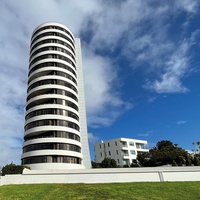
1. 1985–1986, Westwater
10–12 Shelly Beach Road, St Mary’s Bay, Auckland
Glossop Chan Partnership
Darcy Glossop’s Auckland apartment buildings of the 1980s epitomise the decadence of the years just prior to the 1987 sharemarket crash. Kingsview in Remuera, Shangri La in Herne Bay and Shangri La’s near-neighbour Westwater (pictured) were, and still are, luxury buildings. They capitalised on Auckland City Council’s allowance for taller apartment buildings to be built on the ridges of Kohimarama, Remuera, Parnell and Herne Bay. All three of these buildings have circular footprints and only one apartment per floor, meaning 360-degree views and all-day sun. Refer Kaleidoscope ‘Auckland High-rises’, 1986.
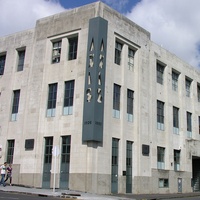
2. 1991–1992, Axis
91 St Georges Bay Road, Parnell, Auckland
Patterson Co-Partners
With the ’87 sharemarket crash, the building industry went quiet, not recovering until the early 1990s. A new phenomenon was immediately apparent: the adaptive reuse of industrial, commercial and warehousing buildings in central city areas as apartments. Among the first was Andrew Patterson’s mixed-use Axis in Chilwell & Trevithick’s old Nestlé Factory (1925–1926). It retains much of the old building fabric and introduces new elements that are easily identifiable as such, including steel signage, gates, bridges, balconies and staircases. See Architecture NZ July/Aug 1993 and Glory Glory 1993.
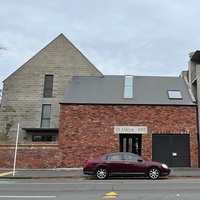
3. 1999, St Mary’s Apartments
868 Colombo Street, Christchurch
Peter Beaven, Architect
The wave of adaptive reuse projects was followed by more purpose-built apartment buildings close to, or in, city centres. Peter Beaven had designed several much-admired 1970s’ townhouse schemes, including Christchurch’s Tonbridge Mews. St Mary’s Apartments came later in his career and demonstrate his interest in contextual architecture, with a layering of historical references. The complex comprises 70 units in blocks of up to four storeys, arranged around two quadrangular courtyards. It is tucked behind a fair-faced brick wall and retains the pitched roofs and exposed concrete block of Christchurch’s renowned brutalism.
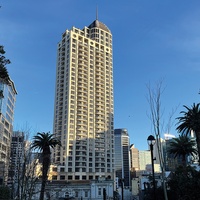
4. 1997–1999, Metropolis Apartments
1 Courthouse Lane, Auckland
Otto Taskovich with Peddle Thorp and Aitken
Among the most ambitious of the purpose-built apartment projects of the mid-to-late 1990s, the Metropolis has 368 apartments. When first completed, it was one of Auckland’s tallest buildings. The façade of John Campbell and Claude Paton’s former Magistrates’ Court (1910–1913) provides an impressive entry. References to 1920s’ and 1930s’ New York skyscrapers can be read into the design of the apartment tower and, intentional or not, the name conjures up images of Fritz Lang’s futuristic 1927 movie, an adaptation of a 1925 novel. See Architecture NZ Sept/Oct 2001.
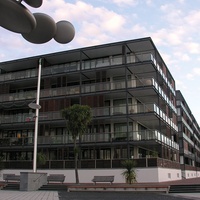
5. 1998–2000, Point Apartments
121 Customs Street West, Viaduct Basin, Auckland
Moller Architects
Team New Zealand’s success in the 1995 America’s Cup earned hosting rights for the next one, stimulating the redevelopment of large chunks of former Ports of Auckland land. Facilities completed for the 2000 regatta included the Viaduct Basin’s ring of restaurants, offices and 380 apartments in four buildings, including the Point Apartments. The Viaduct Point Apartments, also by Moller Architects, were completed in time for the second Cup regatta in 2003. These waterfront apartments were consistently high spec, presenting a glamorous lifestyle and earning a flurry of architecture awards. See Architecture NZ Jan/Feb 2001.
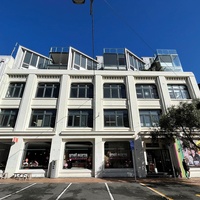
6. 2000–2001, Wakefield Apartments
282 Wakefield Street, Wellington
Architecture Workshop
Adaptive reuse projects with apartments in rooftop additions are thickest on the ground in Wellington. The Wakefield Apartments are among the most successful of these. Three explicitly contemporary apartments sit on top of a 1909 heritage building, with vertical continuities between old and new. See Architecture NZ Jan/Feb 2002. The boldest of the rooftop apartment additions is the ocean-liner-like block that hovers above Chews Lane between Willis and Victoria Streets (2004–2009). Chews Lane Precinct earned an NZIA Local Award (urban design) for Athfield Architects in 2009.
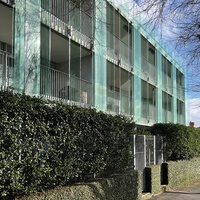
7. 2005, Trinity Apartments
429–431 Parnell Road, Parnell, Auckland
Architectus
Built across the road from Holy Trinity Cathedral and the relocated St Mary’s, this project triggered concern when first mooted because of its scale and contemporary aesthetic in an historic context. But Trinity soon became an Auckland favourite and earned an NZIA National Award in 2007 and Supreme Award in 2008. It has an L-shaped footprint wrapping around two sides of a private swimming pool. The green glass fins on the two street façades (north and east) belie the fact that it is a concrete building with high thermal mass. Timber shutters on the west provide contrast and screen the sun.
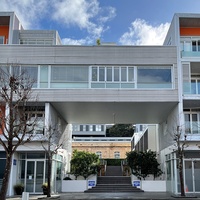
8. 2001–2006, Beaumont Quarter
Beaumont Street, Freemans Bay, Auckland
Studio Pacific Architecture with others
The Beaumont Quarter is a lauded brownfield development, built on former Auckland Gas Company land. Ensuring variety, Studio Pacific Architecture’s master plan retained a number of old buildings and three practices designed the blocks comprising 256 housing units: Studio Pacific Architecture, S333 (Amsterdam) and Engelen Moore (Sydney). The project earned an NZIA New Zealand Architecture Award Urban Design in 2010. The jury emphasised the scheme’s public and community facilities: streets and pathways; small outdoor squares recalling European precedents; and the retention of heritage buildings.
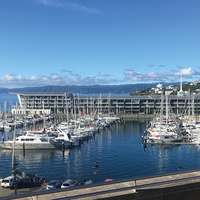
9. 2007–2014, Clyde Quay Wharf Apartments
Clyde Quay Wharf, Wellington
Athfield Architects
Clyde Quay Wharf is mixed-use and a bold landmark, realised by the triumvirate of Willis Bond, Athfield Architects and LT McGuinness. It was built on an historic wharf (1907–1910) that projects out into the harbour and it substantially replaced the city’s old Overseas Passenger Terminal (Morton Calder Fowler and Styles; 1962–1964). The replacement building took its lead from the terminal in form and proportion, and reused some of its elements, notably the spire. The construction challenge included basement carparking under the old wharf. The project earned an NZIA Local Award in 2015.
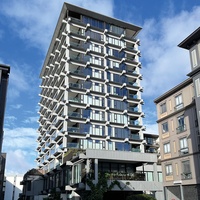
10. 2015–2017, SKHY
44 Khyber Pass Road, Grafton, Auckland
Cheshire Architects
SKHY, named for its location near the corner of Symonds Street and Khyber Pass Road, is a more recent example of the now well-established model of adaptive reuse of a redundant office tower for mixed use, predominantly housing. Notable is the tower’s 1970s’ concrete frame, revealed and celebrated both inside and out. Pip Cheshire likes to combine “the raw and the cooked” and, here, the concrete brings the desired rawness. Stage 2, comprising medium-rise, mixed-use wings alongside the tower, was completed in 2019 and the project earned an NZIA Local Award (multi-housing) in 2020.
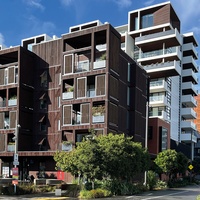
11. 2015–2018, Wynyard Central
Daldy Street, Wynyard Quarter, Auckland
Architectus
Wynyard Central operates on a grand scale in a former marine and fishing district, with 113 residential units of different sizes and types to accommodate a range of occupants in blocks called apartments (an 11-storey component), pavilions (a five-storey building) and townhouses (a three-storey component). It has green roof planting and earned 7 and 8 Homestar certification for sustainability and energy efficiency. The inclusion of cafés and shops at ground-floor level is also significant. The mixed-use approach provides amenity for residents and contributes to street life. See Architecture NZ Nov/Dec 2019.
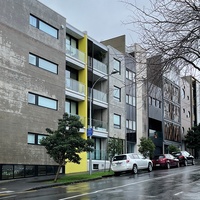
12. 2016–present, Vinegar Lane
Ponsonby, Auckland
Multiple, including Isthmus Group
This site, formerly used for the production of yeast products, stood empty for several years after its initial developers went into receivership. A new master plan by Isthmus included a supermarket and various other uses, realised incrementally from 2016. Isthmus refers to Vinegar Lane as “fine-grained urbanism”, with its many small lots intended to be more in keeping with the character and grain of the historic suburb than a major new building would have been. The sites are freehold, with multiple owners, architects and construction companies contributing under the umbrella of Isthmus’ design manual.
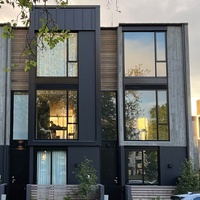
13. 2019–2022, Worcester Terraces
Worcester Street, Christchurch
Sheppard & Rout
The medium-density redevelopment of inner-city areas has been a key part of Christchurch’s earthquake rebuild, including the 7.7-hectare East Frame project (now One Central). Primarily developed by Fletcher Living, it was master-planned by Architectus and DKO Architecture, with 900 homes and much greenspace. Of the buildings completed to date, Architectus’ Bedford Apartments and Terraces and Sheppard & Rout’s Worcester Terraces have earned NZIA New Zealand Awards (2021 and 2023 respectively). As at Vinegar Lane, individual dwellings are narrow, creating the effect of fine-grain, mostly to two and three storeys.
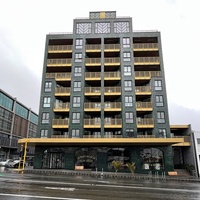
14. 2021–2024, The Greenhouse
20 Williamson Avenue, Grey Lynn, Auckland
Ockham Residential
Ockham is one of a new breed of developers committed to building good quality medium- and high-density housing at more affordable prices. The company aims to build close to public transport routes and uses quality materials and good detailing to minimise future maintenance costs. Co-founder Mark Todd describes The Greenhouse as Ockham’s best yet. It has 93 apartments of varying sizes and is notable for its green-glazed brick cladding, selected to eliminate the need for repainting while also creating a vivid and memorable image, in turn celebrated in the name.
OTHER ADDRESSES
1914–1915, Middle Courtville
9 Parliament Street, Auckland
A. Sinclair O’Connor
New Zealand’s oldest extant block of purpose-built, self-contained apartments.
1985–1989, Oriental Bay Apartments
226 Oriental Parade, Wellington
Athfield Architects
One of the country’s most overtly postmodern apartment buildings.
2003–2005, Lighter Quay
75–83 Halsey Street, Auckland
Includes North by Studio Pacific Architecture in association with Peddle Thorp Architects (2003), and Stratis by Patterson Associates (2003–2005).
2008, Thackeray Street Apartments
30 Thackeray Street, Hamilton
Mercer & Mercer Architects
Winner of an NZIA National Award (multiple housing) in 2009.
2018, Daisy
11 Akepiro Street, Mount Eden, Auckland
Ockham Residential
The first Auckland apartment building to achieve a 10 Homestar rating.
2015–2018, 132 Halsey
132 Halsey Street, Wynyard Quarter, Auckland
Athfield Architects
2020–2021, 30 Madden
30 Madden Street, Wynyard Quarter, Auckland
Studio Pacific Architecture
SOURCES
Documenting the extent of New Zealand’s housing problems, and readily available online, is Alan Johnson, Philippa Howden-Chapman and Shamubeel Eaqub’s A Stocktake of New Zealand’s Housing (Wellington: Ministry of Business, Innovation and Employment, 2018). The full reference to Peter Dyer’s book is Rottenomics: The Story of New Zealand’s Leaky Building Disaster (Auckland: David Bateman, 2019). There is no published history of New Zealand apartment buildings to date but Catherine Foster’s Apartment Living New Zealand (Auckland: Penguin, 2017) discusses 20 schemes, mostly from the experience of architects, owners and occupiers. There is plenty of guidance on how to do density well — in the North Shore City Council’s Good Solutions Guide for Apartments of 2007, for example, and Guy Marriage’s books, Modern Apartment Design (London and New York: Routledge, 2022) and Medium: A Technical Design Guide for Creating Better Medium Density Housing in Aotearoa New Zealand (Auckland: EBOSS, 2022), also available online.

The Itinerary series is supported by Dulux Colours of New Zealand. Dulux Colour Specialist Davina Harper has selected a Colours of New Zealand palette based on this itinerary. See the full range and order colour samples here.


